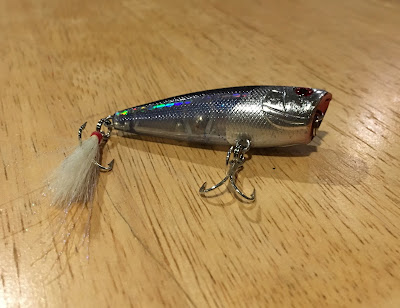You have probably heard that the fish aren't biting when you see them hitting the top of the water. Although fish seem to become more difficult to catch when this is happening, with a little bit of patience they can still be convinced to bite. You will need to adjust your tactics in order to catch them and this is an excellent time to put your topwater fishing lures into action.
Fishing with topwater lures is fairly easy, but it is a much slower fishing method than the normal cast and retrieve method used with jigs and other crank baits. The best method I have found to use with any topwater lure is to cast the lure and let it sit until the ripples caused by its hitting the water are gone. Once the ripples are gone twitch your rod to move the lure slightly and repeat the process waiting until the resulting ripples are once again gone. Continue repeating these steps until the lure has been completely retrieved.
You can move the lure just a tiny bit or you can choose to make it move several inches at a time. Experiment with this as some days the fish will attack it with only a slight movement and other days they will have to see it move a bit before they're convinced it will make a good meal.
Another lure that can be used similar to a topwater lure is a floating shallow diver. One method for using these lures is the same as for topwater lures. An alternative to the topwater method for a floating/shallow-diving lure is to reel it in a foot or two after the initial ripples are gone causing it to dip below the surface of the water before allowing it to pop back up to the surface. As with the above methods allow the ripples to dissipate before moving the lure again.
There are a seemingly infinite number of different topwater lures available in all different price ranges. Bigger and more expensive is most definitely not always better. Many times a smaller lure will attract fish before the bigger ones will.
By patiently working your topwater lures you can bring in fish when no-one else seems to be having any luck at all.
- Any day in the outdoors is a good day
Dog Proof Traps For Raccoons
 |
| One of the Raccoons caught on my trap line last season |
What are Dog Proof Traps
Dog proof traps were designed in order to prevent catching domestic dogs while trapping raccoons. They are cylindrical in shape with a heavy spring activated wire which is pushed into place and set with a locking mechanism. These traps are open at the top and have a trigger positioned near the bottom. When a raccoon reaches in to retrieve the bait, they will typically hit this trigger causing the wire to be released which in turn catches their leg in the trap between the wire and the outer edge of the trap.
Types of Dog Proof Traps
There are two basic types of dog proof traps. One type has a "pull" type trigger which sets the trap off when the trigger is pulled upwards while the coon attempts to bring the bait out the top of the trap. The other type of trap has a double action trigger also known as a push-pull trigger which can be set off by being pushed down or pulled up as the name implies.
Setting Dog Proof Traps
Setting the dog proof traps is fairly easy. You can purchase a setting tool or you can use the tailgate of your truck. I typically lay the trap on my tailgate wire side down and push the "can" down forcing the wire loop at the top to move to the set position. With the trap in this position I set the locking mechanism on the side of the can and place a piece of PVC pipe about six to eight inches long inside. This prevents accidental discharge of the trap while making my way to the trap line. To ensure the raccoon will not take off with your trap, it needs to be secured to something. Stakes about eighteen inches long made out of rebar work very nicely for this purpose. Use a mallet to put the stake into the ground and attach the trap to it with a piece of heavy duty bailing wire.
Baiting Dog Proof Traps
When using a liquid bait simply douse a cotton ball with your bait and place it below the trigger (this should be done before setting the trap). I don't recommend using liquid baits when the temperature is going to get below freezing as it can render your trap unable to "fire." If you are using a solid type bait (dog food, pelleted bait, etc....) pour just enough bait into the trap to cover the trigger (this type of bait can be added after setting the trap). When baiting a trap that has been set, be extremely careful that your fingers are nowhere near the opening as you DO NOT want to get your finger caught in there!
Why Use Dog Proof Traps
The use of dog proof traps will enable you to set trap lines in many more places than using traditional methods of trapping. Many landowners will not allow trappers to set lines on their property unless dog proof traps are being used. Dog proof traps will not eliminate catching all non-targeted animals, but they will greatly reduce the number of those animals being caught. These traps will enable you to release any animal you do not wish to dispatch without harm. The main non-target animal I tend to catch with dog proofs is opossum; however, you cannot rule out the possibility of catching the occasional skunk.
I hope this information helps you understand the basic principles of using dog proof traps. I have found them to be relatively easy to use and very effective in catching raccoons.
- Any day in the outdoors is a good day
Subscribe to:
Posts (Atom)

